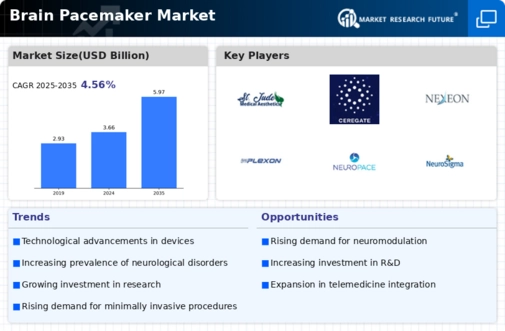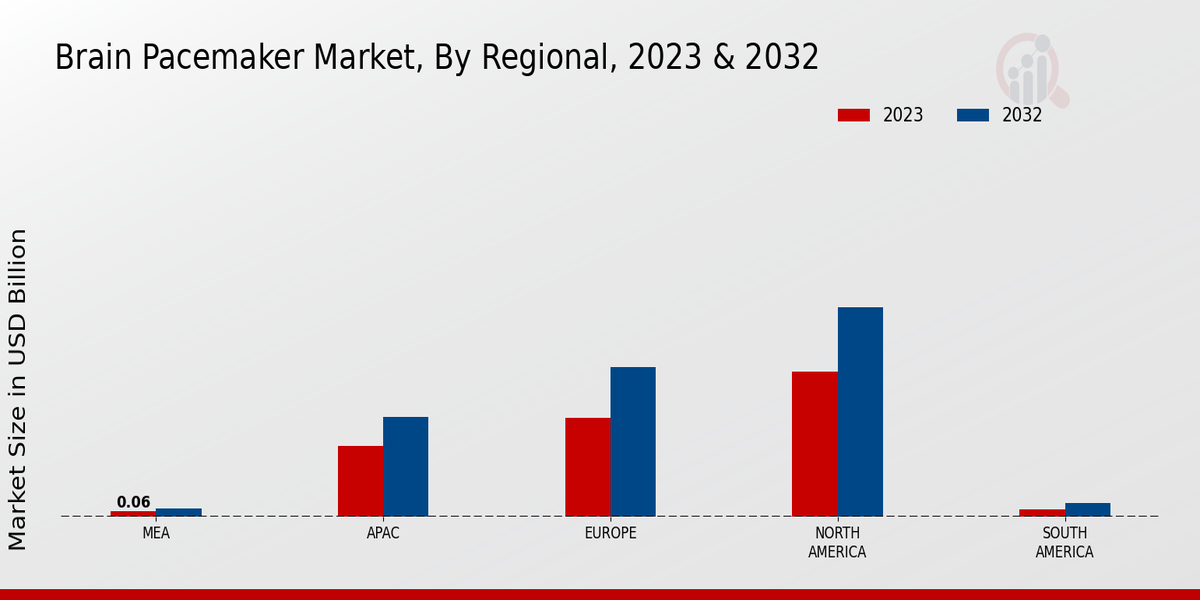Market Growth Projections
The Global Brain Pacemaker Market Industry is projected to experience substantial growth over the next decade. In 2024, the market is anticipated to reach 3.66 USD Billion, with expectations to expand to 5.97 USD Billion by 2035. This growth trajectory suggests a compound annual growth rate (CAGR) of 4.55% from 2025 to 2035. The increasing prevalence of neurological disorders, technological advancements, and supportive regulatory environments are key factors driving this expansion. As the market evolves, stakeholders are likely to witness significant opportunities for innovation and investment, positioning brain pacemakers as a vital component of modern neurological care.
Regulatory Support and Reimbursement Policies
The Global Brain Pacemaker Market Industry is positively impacted by supportive regulatory frameworks and reimbursement policies. Governments are increasingly recognizing the importance of neurostimulation devices in treating neurological disorders, leading to streamlined approval processes for new technologies. Additionally, favorable reimbursement policies encourage healthcare providers to adopt brain pacemakers, as they alleviate financial burdens on patients. This regulatory support not only enhances market accessibility but also fosters innovation within the industry. As a result, the combination of supportive regulations and reimbursement strategies is likely to drive the growth of the market, ensuring that patients have access to these advanced therapeutic options.
Growing Investment in Healthcare Infrastructure
The Global Brain Pacemaker Market Industry benefits from increasing investments in healthcare infrastructure, particularly in developing regions. Governments and private entities are recognizing the importance of enhancing healthcare systems to address the rising burden of neurological disorders. For example, initiatives aimed at improving access to advanced medical technologies are being implemented in various countries. This investment not only enhances the availability of brain pacemakers but also fosters research and development in neurostimulation therapies. As a result, the market is projected to reach 5.97 USD Billion by 2035, reflecting the positive impact of these investments on patient care.
Increasing Prevalence of Neurological Disorders
The Global Brain Pacemaker Market Industry is experiencing growth due to the rising incidence of neurological disorders such as Parkinson's disease, epilepsy, and depression. As the global population ages, the prevalence of these conditions is expected to increase, necessitating advanced treatment options. For instance, the World Health Organization indicates that neurological disorders account for a significant portion of the global disease burden. This trend is likely to drive demand for brain pacemakers, which offer innovative solutions for managing symptoms and improving patients' quality of life. Consequently, the market is projected to reach 3.66 USD Billion in 2024, reflecting the urgent need for effective therapies.
Technological Advancements in Neurostimulation Devices
The Global Brain Pacemaker Market Industry is significantly influenced by rapid technological advancements in neurostimulation devices. Innovations such as closed-loop systems, which provide real-time feedback and adjust stimulation parameters, enhance the efficacy of brain pacemakers. These advancements not only improve patient outcomes but also increase the appeal of these devices among healthcare providers. Furthermore, the integration of wireless technology facilitates remote monitoring and management, thereby expanding the market's reach. As a result, the market is expected to grow at a CAGR of 4.55% from 2025 to 2035, indicating a robust future driven by continuous innovation.
Rising Awareness and Acceptance of Neurostimulation Therapies
The Global Brain Pacemaker Market Industry is witnessing increased awareness and acceptance of neurostimulation therapies among patients and healthcare professionals. Educational campaigns and advocacy efforts are playing a crucial role in informing stakeholders about the benefits of brain pacemakers in managing neurological conditions. This growing awareness is likely to lead to higher adoption rates, as patients seek effective alternatives to traditional treatments. Moreover, healthcare providers are increasingly recognizing the potential of these devices to improve patient outcomes. Consequently, this trend is expected to contribute to the overall growth of the market, as more individuals turn to neurostimulation therapies for relief.






















